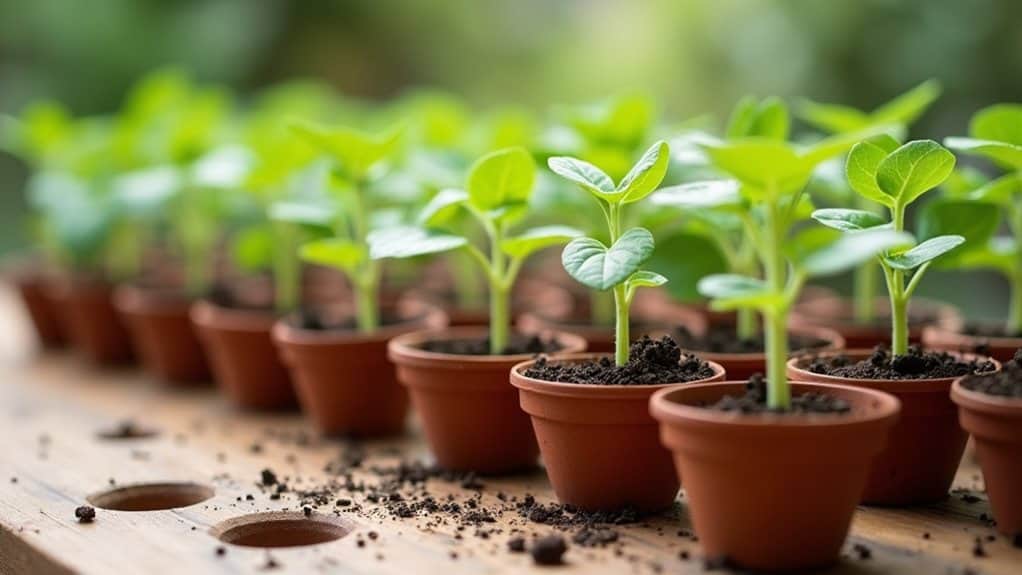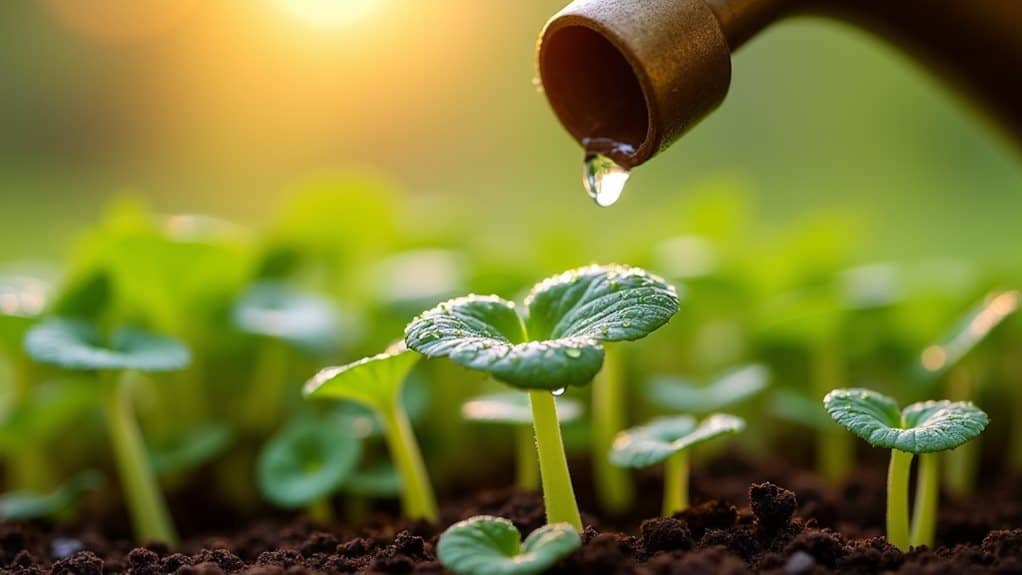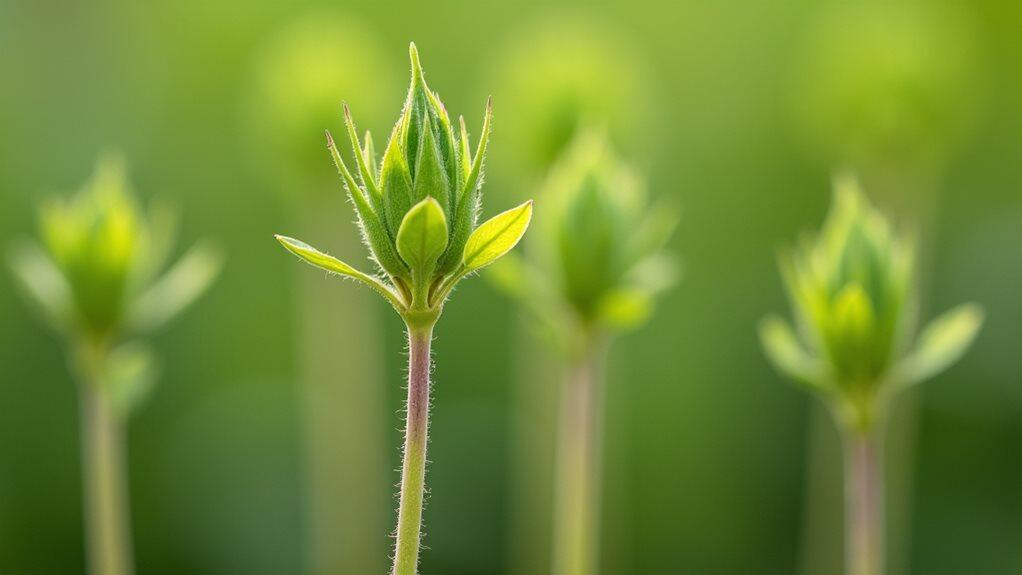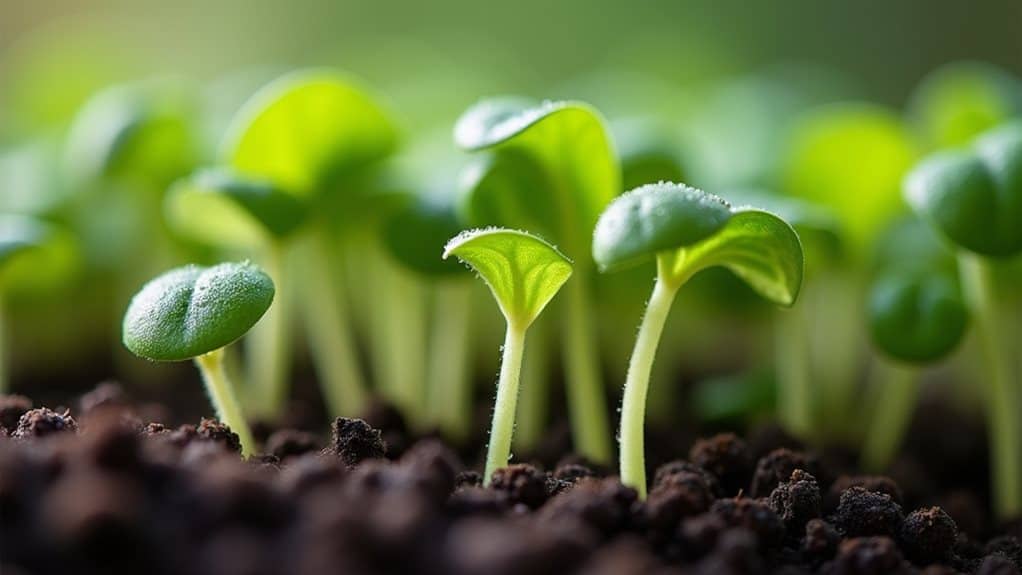Edible Sunflower Shoots: How to Grow Them
You can easily grow crunchy, nutty sunflower shoots by starting with black oil sunflower seeds, rinsing them thoroughly, and soaking overnight before planting in well-draining containers filled with moist potting soil. Keep your setup between 70-100°F with 12-16 hours of daily light, then harvest those tender shoots at the two-leaf stage around day 10-12 for the best flavor—trust me, timing’s everything to avoid bitter disappointment! There’s so much more to mastering this rewarding process.
Quick Guide
- Select black oil sunflower seeds, rinse thoroughly, and treat with food-grade hydrogen peroxide to prevent fungal issues.
- Use containers with drainage holes filled with moistened coco coir or potting soil amended with compost.
- Maintain 70°F-100°F temperature with 12-16 hours daily light and good air circulation for optimal growth conditions.
- Harvest at two-leaf stage around 10-14 days after planting when leaves are fully expanded and stems remain tender.
- Cut shoots at soil level with sharp scissors, rinse gently, and refrigerate in sealed bags for freshness.
Choosing the Right Sunflower Seeds for Growing Shoots

When you’re ready to plunge into the exciting world of growing your own edible sunflower shoots, the first and most essential step is selecting the right seeds—because trust me, not all sunflower seeds are created equal for this tasty adventure!
You’ll want black oil sunflower seeds for their lightning-fast germination and tender shoots, or confection varieties like Mammoth for plumper options. Remember that variety selection significantly impacts both the flavor profile and overall yield of your homegrown shoots. Additionally, ensuring nutrient-rich soil can greatly enhance the flavor and health of your sunflower shoots.
Proper Seed Preparation and Soaking Techniques
Now that you’ve got your perfect sunflower seeds picked out, it’s time to get them ready for their sprouting expedition—and let me tell you, proper preparation makes all the difference between disappointing duds and spectacular shoots!
Start by rinsing those seeds multiple times in cool, filtered water, removing any floaters since they’re basically freeloaders. To prevent fungal issues that can plague these soft-shelled seeds, treat them with one teaspoon of food-grade hydrogen peroxide per 25 grams of seeds before soaking. Additionally, ensuring that your seeds are planted in well-amended soil with organic matter will greatly enhance their growth potential.
Setting Up Your Growing Containers and Medium

Now that you’ve got your sunflower seeds properly soaked and ready to go, it’s time to set up the perfect growing environment that’ll turn those little seeds into delicious, crunchy shoots you can munch on during your next camping trip!
You’ll need to choose the right containers with proper drainage holes, because trust me, waterlogged seeds turn into a moldy mess faster than you can say “outdoor expedition,” and then select a growing medium like coco coir or potting soil that’ll give your seeds the perfect foundation to sprout. It’s important to remember that using the right soil type can significantly impact your plants’ growth and health.
Getting these two elements right from the start will save you tons of frustration later, plus you’ll have fresh greens to add to your trail mix or camp salads in just a few days!
Container Selection and Drainage
Before you can grow those crunchy, nutty sunflower shoots that’ll make your camping breakfast taste like a gourmet escapade, you’ve got to nail the foundation—and that means choosing the right container with proper drainage that won’t turn your sprouting dreams into a soggy nightmare.
Grab two trays with drainage holes, drill extras if needed.
Soil Preparation and Depth
While your containers are sitting there looking all professional with their drainage holes, it’s time to create the perfect growing environment that’ll turn those hulking sunflower seeds into tender, crispy shoots your taste buds will thank you for.
Fill containers with moistened coco coir or loose potting soil amended with compost for ideal drainage and fertility.
Creating Optimal Environmental Conditions
Since growing edible sunflower shoots successfully depends heavily on getting the environmental conditions just right, you’ll want to pay close attention to four key factors that can make or break your microgreen adventure: light, moisture, growing medium, and airflow.
Think of it like setting up the perfect campsite—everything needs to work together harmoniously for success!
Temperature Requirements for Healthy Growth

When you’re growing edible sunflower shoots, getting the temperature just right can make the difference between a fantastic harvest in two weeks versus waiting around for three weeks with disappointing results.
Think of these little green gems as being somewhat picky about their comfort zone – they absolutely love that sweet spot between 70°F and 100°F during the day, where they’ll practically sprint to maturity, but drop below 55°F and they’ll sulk like a teenager who’s been asked to clean their room.
I’ve learned the hard way that cold temperatures will slow everything down to a crawl, while excessive heat above 100°F can actually stress them out and damage those tender shoots you’re working so hard to grow, so you’ll want to keep a close eye on both extremes.
Optimal Temperature Range
Have you ever wondered why your sunflower shoots sometimes grow like they’re racing toward the sun, while other times they seem to be taking a leisurely stroll through their growth cycle?
You’ll want to keep your growing area between 70°F and 78°F for the happiest shoots, though they’ll still thrive from 64°F to 91°F.
Cold Vs Heat Effects
Temperature extremes can make or break your sunflower shoot growing expedition, and I’ve learned this lesson the hard way during my own indoor gardening experiments in my chilly basement during winter months.
Cold temperatures below 55°F slow growth dramatically, extending harvest time to three weeks while increasing mold risks, whereas warm conditions between 70-100°F accelerate development beautifully.
Light and Air Circulation Needs
Why do sunflower shoots need such specific lighting conditions when they seem so easy to grow?
You’ll need 12-16 hours of full-spectrum light daily, mimicking natural sunlight’s blue and red wavelengths. Without proper lighting, your shoots become leggy weaklings!
Good air circulation prevents mold disasters too—trust me, stagnant air kills crops faster than you’d expect.
Watering Methods and Moisture Management

When you’re perfecting the art of watering sunflower shoots, you’ll uncover that bottom watering becomes your secret weapon for preventing those dreaded fungal disasters that can wipe out your entire crop overnight!
Simply place your seed tray in a water-filled larger tray, let it absorb for twenty seconds, then drain excess water completely to avoid soggy conditions.
Daily Care and Maintenance Practices
Beyond perfecting your watering technique, you’ll uncover that successful sunflower shoot cultivation hinges on establishing a rock-solid daily routine that’ll change you from nervous beginner into confident microgreen expert!
Check moisture levels twice daily, flick off loose seed coats, monitor for white fuzzy mold, and maintain proper airflow—these simple steps prevent disasters completely!
Recognizing the Perfect Harvest Time

You’ll want to catch your sunflower shoots at that magical two-leaf stage, which typically happens around 10-14 days after planting when those adorable little leaves have fully expanded and look absolutely perfect for snacking – trust me, I’ve learned this timing through plenty of trial and error during my own camping excursions!
If you wait too long and let them grow beyond this sweet spot, those tender shoots will turn bitter and tough, kind of like how marshmallows taste awful when you burn them over the campfire (and we’ve all been there, right?).
The key is watching for those fully developed first leaves while the stems are still crisp and mild, because once they start getting leggy and developing more leaves, you’ve missed your window for the best flavor.
Two-Leaf Stage Timing
While spotting the perfect two-leaf stage might seem trickier than finding your favorite camping spot in the dark, it’s actually quite straightforward once you know what you’re looking for!
You’ll see two rounded, bright green cotyledons that’ve fully expanded, standing a few inches tall with thick, crunchy stems—perfect for harvesting before any third leaf appears!
Avoiding Bitter Overgrowth
Timing your harvest just right makes all the difference between crunchy, sweet sunflower shoots that’ll make your camping salads sing and bitter, tough stems that’ll have you making faces like you just bit into a raw lemon!
You’ll want to harvest immediately when those first true leaves unfold—usually around day seven to twelve.
Proper Harvesting and Storage Techniques
Once your sunflower shoots reach that perfect 4-inch height with their adorable two-leaf stage on full display, it’s time to get excited about harvesting these crunchy little treasures that’ll make your camping salads absolutely sing!
Grab sharp scissors, cut at soil level, rinse gently, then store unwashed in sealed bags refrigerated for up to five days.
Nutritional Benefits of Sunflower Microgreens

When you’re packing your trail mix and wondering how to squeeze more nutrition into your camping meals without hauling heavy produce up the mountain, sunflower microgreens become your secret weapon – these tiny powerhouses deliver an absolutely stunning nutritional punch that’ll make your regular lettuce look like it’s slacking on the job!
Culinary Uses and Flavor Profile
Beyond their impressive nutritional resume, sunflower shoots bring a pleasingly mild, nutty flavor to your camping kitchen that’ll make you wonder why you’ve been settling for boring trail salads all these years!
Their tender, crunchy texture works beautifully in everything from breakfast wraps to evening stir-fries, adding subtle sweetness without overpowering your carefully planned camp meals.
Wrapping Up
You’ve now got all the tools you need to grow incredible sunflower shoots right in your own kitchen, and trust me, once you taste these crunchy, nutty little powerhouses, you’ll wonder why you didn’t start growing them sooner! Whether you’re adding them to your camping salads or sprinkling them on sandwiches at home, these nutrient-packed microgreens will become your new favorite superfood obsession.






